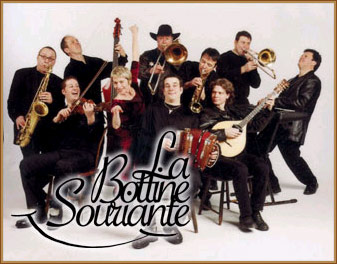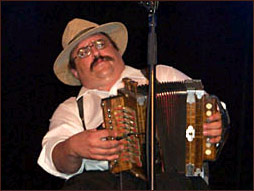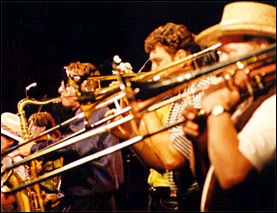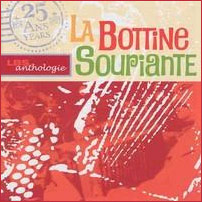"It was like Cajun music on steroids," remarked
one audience member in the wake of La Bottine Souriante's (LBS)
September 27 two-hour concert at the Hopkins Center at Dartmouth
College.
 With
cut-rate prescription drugs increasingly flowing from Canada to the
US, the cascade of endorphins dispensed by Quebec's premier world
music ensemble to a grateful American audience was yet more
life-saving medicine from Canada. In truth, though, appearances by the
nonet are too infrequent this side of the border. So are La Bottine's
recordings on its independent Mille-Pattes label. You can't find them
across the street from the Hopkins at the Dartmouth Book Store, nor
can you buy them at the well-stocked shops at my Amherst/Northampton,
Massachusetts haunting grounds. (No trouble in Amherst to buy new
releases by a half dozen etoiles from land-locked Mali, but the latest
release from nearby Quebec's best band?—let's just say that NAFTA
hasn't yet made a difference.) With
cut-rate prescription drugs increasingly flowing from Canada to the
US, the cascade of endorphins dispensed by Quebec's premier world
music ensemble to a grateful American audience was yet more
life-saving medicine from Canada. In truth, though, appearances by the
nonet are too infrequent this side of the border. So are La Bottine's
recordings on its independent Mille-Pattes label. You can't find them
across the street from the Hopkins at the Dartmouth Book Store, nor
can you buy them at the well-stocked shops at my Amherst/Northampton,
Massachusetts haunting grounds. (No trouble in Amherst to buy new
releases by a half dozen etoiles from land-locked Mali, but the latest
release from nearby Quebec's best band?—let's just say that NAFTA
hasn't yet made a difference.)
Fifteen minutes before showtime, I was perplexed to discover program
notes with no mention of group founder, Yves Lambert, who I later
learned had pe rformed his final gig with LBS during its annual New
Years Eve concert in Montreal. More than anyone else, the avuncular,
mustachioed lead singer/accordionist had been synonymous with the
26-year-old ensemble. Founded in 1977, La Bottine Souriante was for
its first dozen years entirely acoustic, featuring fiddle, guitar,
mandolin, harmonica, and Yves' three-row accordion. And of course, the
group always brought along its perpetual foot percussion—hence, the
band's name [in English], The Smiling Boot. During its first decade,
LBS established a repertoire that emphasized reels, jigs, an
occasional ballad, and irreverent, call-and response burlesques
lampooning everything from men of the cloth to couples under the
sheets. It wasn't until the end of the 1980s though that the band
began to move toward its current configuration, with the arrival of
jazz bassist Reginald Archambault and jazz pianist, saxophonist, and
arranger, Jean Frechette. By 1990, Frechette had moved full-time to
saxophone and the group had added a jazz pianist, two trombones and a
trumpet. It was the beginning of an entirely new genre—the planet's
first synthesis of traditional Quebec-Celtic music with jazz-based
horn arrangements. Now, thirteen years later, with Archambault and
Jean Frechette as the band's elder statesmen, a single question loomed
large: would the tail (the horn arrangements) decisively wag the dog
of tradition? rformed his final gig with LBS during its annual New
Years Eve concert in Montreal. More than anyone else, the avuncular,
mustachioed lead singer/accordionist had been synonymous with the
26-year-old ensemble. Founded in 1977, La Bottine Souriante was for
its first dozen years entirely acoustic, featuring fiddle, guitar,
mandolin, harmonica, and Yves' three-row accordion. And of course, the
group always brought along its perpetual foot percussion—hence, the
band's name [in English], The Smiling Boot. During its first decade,
LBS established a repertoire that emphasized reels, jigs, an
occasional ballad, and irreverent, call-and response burlesques
lampooning everything from men of the cloth to couples under the
sheets. It wasn't until the end of the 1980s though that the band
began to move toward its current configuration, with the arrival of
jazz bassist Reginald Archambault and jazz pianist, saxophonist, and
arranger, Jean Frechette. By 1990, Frechette had moved full-time to
saxophone and the group had added a jazz pianist, two trombones and a
trumpet. It was the beginning of an entirely new genre—the planet's
first synthesis of traditional Quebec-Celtic music with jazz-based
horn arrangements. Now, thirteen years later, with Archambault and
Jean Frechette as the band's elder statesmen, a single question loomed
large: would the tail (the horn arrangements) decisively wag the dog
of tradition?
The answer during the two-hour, 24-number concert was both yes and no.
The evening began with La grondeuse (The Grumbling Woman ), a spirited
reel which opened with an acoustic trio of guitar, fiddle, and
percussive feet stating the chorus. Behind the band's front line of
acoustic virtuosos in their twenties, stood the brass players—a full
generation older—poised to play. Next, the saxophonist joined the
acoustic musicians in restating the chorus, adding a few
extracurricular riffs of his own. Then, the electric bass, electric
piano, and the remaining horns weighed in, serving up a funky
interlude that set the table for the full nonet—now including
Lambert's young successor, Pierre-Luc Dupuis, on button box. That
cranked-up climax thoroughly won the audience over, immersing them
both physically and emotionally in the music.
In its build-up of instrumental fire power, La grandiose mirrored La
Bottine's own evolution from a spirited acoustic ménage to a
high-octane, musical hybrid. That synthesis, in truth, owes more than
a little to the impeccable, inventive ensemble arrangements of the
 band's saxophonist, Jean Frechette. Throughout the two-hour concert,
the horns, electronic keyboard, and electric bass never obscured the
acoustic instruments. You could always hear each voice and instrument
distinctly—a testament to Frechette's (and the LBS soundman's) mastery
of ensemble balance and dynamics. Unlike jazz and musette ensembles,
LBS seldom swings. Instead, like much rock music, the band drives
forcefully and at considerable volume on the beat. But this was no
rock concert-especially with the band's traditional acoustic
instruments and their indefatigable traditional dance rhythms always
front and center. (A further nod to the band's roots in dance was the
addition of Sandy Silva, a percussive dancer with fluency in Celtic,
jazz, and flamenco forms. In the up-tempo offerings, her lithe,
mercurial stage presence consistently goosed up the players and their
audience to higher energy levels.) band's saxophonist, Jean Frechette. Throughout the two-hour concert,
the horns, electronic keyboard, and electric bass never obscured the
acoustic instruments. You could always hear each voice and instrument
distinctly—a testament to Frechette's (and the LBS soundman's) mastery
of ensemble balance and dynamics. Unlike jazz and musette ensembles,
LBS seldom swings. Instead, like much rock music, the band drives
forcefully and at considerable volume on the beat. But this was no
rock concert-especially with the band's traditional acoustic
instruments and their indefatigable traditional dance rhythms always
front and center. (A further nod to the band's roots in dance was the
addition of Sandy Silva, a percussive dancer with fluency in Celtic,
jazz, and flamenco forms. In the up-tempo offerings, her lithe,
mercurial stage presence consistently goosed up the players and their
audience to higher energy levels.)
All night long, Frechette's horn arrangements conveyed an eclectic bag
of tricks. The horns periodically laid down a feel-good, dynamically
controlled harmonic bed behind the other instruments. They reinforced
melodic statements and forward momentum with their collective
syncopations and drive. Frequently, the horns divided forces,
unleashing polyrhythms against one another and the rhythm section. On
one occasion, they shadowed one another canonically; on another they
separated into four separate voices, conversing with New Orleans brio.
Seven numbers into the concert, La Bottine revealed its mastery of
dynamics with La reel des soucoupes volan tes (The Flying Saucer Reel).
The horns' sinuous slides up and down the chromatic scale coupled with
elastic crescendi and diminuendi (continuous increases and decreases
of volume) created soaring, swooping effects that defied garden
variety musical gravity. tes (The Flying Saucer Reel).
The horns' sinuous slides up and down the chromatic scale coupled with
elastic crescendi and diminuendi (continuous increases and decreases
of volume) created soaring, swooping effects that defied garden
variety musical gravity.
La Bottine Souriate was far more than the sum of its reels. Cadenced
between most of them were irreverent, call-and-response vocals about
dissolute clerics;
picaresque, amorous trysts; binges with the bottle; and other
manifestations of la joie de vivre. Two of those offerings were
fascinating world-music hybrids: Le plus beau jour (The Most Beautiful
Day) combined an edgy Latin piano motif against traditional Celtic
cadences; Dans Paris y'a t'une brune (The Brunette from Paris) married
French Celtic influences to a brass-propelled figure straight out of a
Cairo recording studio. To keep things in proper perspective, the band
staked out musical turf for the Devil and his minions, especially in
Le demon sort de l'enfer (The Devil Comes out of Hell), a litmus for
the vocal and theatrical talents of young Pierre-Luc Dupuis. In the
song, the Devil turns up in town, fingering in separate verses its
respectable members-its doctor, banker, lawyer, priest, etc.-for the
one-way trip of a lifetime. Dupuis, as the Devil, handled his satanic
portfolio with relish, investing his expressive baritone, facial
gestures, and body language with just the right brew of sinister
smugness. On stage, he made a point to visit a different band member
with each verse, booking them all for southward passage. At the song's
end, the four horns gathered at stage center for a cacophonous coda to
downward mobility, with horn bells and slides thrusting downward,
downward, downward . . .
After the concert, bassist Reginald Archambault and dancer Sandy Silva
met briefly with audience members to answer questions. Yves Lambert,
noted Archambault, had founded the band 26 years ago with fellow
traditionalist musicians from the general vicinity of Joliette, a town
130 miles north of Montreal near the St. Lawrence. The band's young
acoustic musicians, he continued, hail from the same area, a hotbed of
traditional Quebec-Celtic music that has assimilated French Canadian
and Maritime province influences. "When we're overseas in places like
Scotland, we can hear the kinship between their reels and ours," he
remarked. When an audience member asked if the band played any
differently for French Canadian versus American audiences, the bassist
replied that they did not, adding, though, that understanding the
band's French lyrics was bound to enhance the listening experience.
Then again, offered Ms. Silva, "you should join us for our annual
concerts around New Years at the Spectrum in Montreal. They are
absolutely wild." Having just survived a frequently wild two-hour
concert in Hanover, I could only imagine what an absolutely wild New
Years Eve experience with La Bottine Souriante in Montreal might
entail.
The group's most recent releases are Cordial and Anthologie, the
latter a 16-track retrospective of the band's entire career. You can
order both indispensable discs and check out the band's concert
schedule at www.millepattes.com |